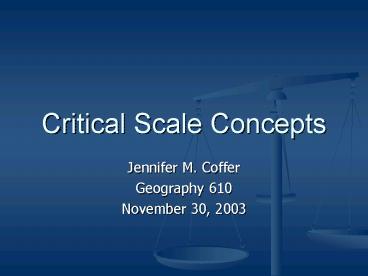Critical Scale Concepts - PowerPoint PPT Presentation
1 / 18
Title:
Critical Scale Concepts
Description:
'the problem of relating phenomena across scales is the central problem in ... Scale refers to the spatial and/or temporal dimensions of an ... www.tripod.com ' ... – PowerPoint PPT presentation
Number of Views:29
Avg rating:3.0/5.0
Title: Critical Scale Concepts
1
Critical Scale Concepts
- Jennifer M. Coffer
- Geography 610
- November 30, 2003
2
- the problem of relating phenomena across scales
is the central problem in biology and in all of
science - -- Levin, 1992
www.in-cities.com
3
Broad Scale Environmental Concerns
- Acid rain
- Global Climate Change
- Habitat Fragmentation
- Biodiversity
4
- Scale refers to the spatial and/or temporal
dimensions of an object or a process - Spatial Dimension space
- Temporal Dimension time
Turner,2001
5
rst.gsfc.nasa.gov
6
sorrel.humbolt.edu
7
Characteristics of Scale
- Grain Finest level of spatial resolution
possible within a given data set - Extent Size of the study area or the duration
of time under consideration
Turner, 2001
8
Scale Terminology
- Absolute Scale the actual distance, time, or
area - Relative Scale scale that describes the
relative distance, direction or geometry based on
some functional relationship
9
Resolution
- - Precision of measurement grain size, if spatial
www.msss.com
10
Three Scale Issues- Haggett (1963)
- 1. The Scale Coverage Problem
- - The surface of the Earth is so large that its
enormity posed difficulties in mapping and
understanding the spatial variability
11
- 2. The Scale Linkage Problem
- Direct consequence of the scale coverage problem
- The relation of relatively fine-scale data to a
broader spatial scale.
www.tripod.com
12
- conclusions derived from studies made at one
scale should not be expected to apply to problems
whose data are expressed at other scales. - every change in scale will bring about the
statement of a new problem, and there is no basis
for assuming that associations existing at one
scale will also exist at another. - - McCarty (1956)
13
- 3. The Scale Standardization Problem
- Most social data were reported for areas rather
than points and that these areas vary widely in
size and shape, both between and within
countries. - -Haggett 1963
14
Identifying the Right Scale
- That there is no single correct scale or level
at which to describe a system does not mean that
all scales serve equally well or that there are
not scaling laws. - - Levin, 1992
www.mpcplating.com
15
Scaling Up
- Challenges
- Correctly defining the spatial and temporal
heterogeneity of the fine-scale information - Correctly integrating or aggregating this
heterogeneity to the broader scale - -King, 1991
16
Conclusions
- Scales must be selected based on the question or
objective of a study. - Methods of scale selection remain a current
challenge in geographic research.
17
Bibliography
Delcourt, H.R., P.A. Delcourt, and T. Webb,1983.
Dynamic plant ecology the spectrum of vegetation
change in space and time. Quaternary Science
Review 1153-175. King, A.W. 1997. Hierarchy
theory a guide to system structure for wildlife
biologists. In J.A. Bissonette, ed. Wildlife and
Landscape Ecology. Effects of Pattern and Scales,
pp.185-212. Springer-Verlang, New York. Levin,
S.A. 1992 The problem of pattern and scale in
ecology. Ecology 731943-1983. Schneider, D.C.
1994. Quantitative Ecology. Spatial and Temporal
Scaling. Academic Press, San Diego,
California. Turner, M.G., Gardner, R.H., and R.V.
ONeill, 2001. Landscape Ecology in Theory and
Practice., Springer-Verlang New York, Inc. Wiens,
J.A. 1989. Spatial Scaling in ecology. Functional
Ecology 3385-397.
18
Questions?































